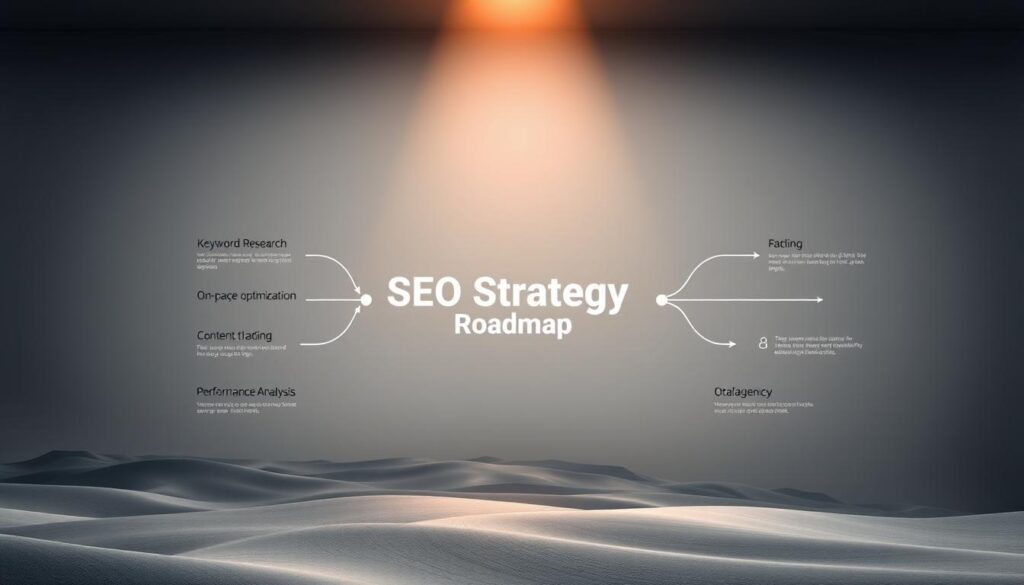Imagine your website as a library filled with valuable books. Without a proper catalog system, visitors might never find what they need. Search engine optimization (SEO) acts like that catalog, helping platforms like Google discover, organize, and showcase your pages to the right audience. It’s not magic—it’s about making your content easy to understand for both users and automated crawlers.
At its core, SEO ensures your site meets quality standards so it appears higher in results. Think of it as a roadmap guiding people to answers they’re looking for. While there’s no shortcut to the top spot, consistent efforts like improving page structure or using relevant keywords build credibility over time.
This process starts with search engines scanning your pages to determine their purpose. By aligning your content with what users need, you create a win-win: visitors get helpful information, and your site earns better visibility. Tools like Google Search Console offer insights, but success ultimately depends on clarity and relevance.
Key Takeaways
- SEO helps search engines find and rank your content accurately.
- High-quality pages prioritize user needs and technical readability.
- Long-term strategies outperform quick fixes for sustained visibility.
- Balancing creativity with best practices attracts both people and algorithms.
- Regular updates and monitoring keep your site aligned with search trends.
Introduction to SEO
In a world where millions compete for attention, standing out online requires strategy. Search engine optimization combines creativity with technical precision to help websites connect with their ideal audiences. Let’s break down how this works.
What is SEO?
SEO involves refining your site’s content, structure, and backend setup to improve its visibility in unpaid results. For example: a local bakery might optimize its pages for phrases like “best birthday cakes near me” to attract nearby customers. This process includes:
- Researching terms your audience uses
- Creating helpful, original content
- Ensuring fast loading speeds
Why SEO Matters Today
Over 60% of clicks go to the top three organic results. Without optimization, even great content risks getting buried. A user-friendly web design and mobile compatibility are now essential—Google prioritizes sites offering positive experiences.
| Factor | SEO Benefit | Impact Timeline |
|---|---|---|
| Keyword Alignment | Higher relevance | 3-6 months |
| Technical Health | Fewer errors | Immediate |
| Content Quality | More shares | 6-12 months |
Businesses investing in SEO see 3x more traffic than those relying solely on ads. As algorithms evolve, focusing on genuine value keeps sites adaptable in the modern web environment.
Understanding Core SEO Concepts
To effectively reach your audience online, it’s crucial to grasp how platforms prioritize content. Three elements drive this process: discovery, evaluation, and ranking. Let’s explore how these pieces fit together.

How Search Engines Work
Automated bots, called crawlers, scan websites like librarians organizing books. They follow links to find new pages and update existing ones in their index. This massive catalog helps platforms deliver answers quickly when users ask questions.
Algorithms then analyze indexed pages using hundreds of signals. Think of these formulas as chefs tasting dishes to pick the best recipes for a menu. They prioritize pages that load fast, answer queries clearly, and come from trusted sources.
Key Ranking Factors
While specifics vary, four elements consistently influence visibility:
- Content quality: Original, detailed information that solves problems
- Backlinks: Recommendations from reputable sites
- Technical setup: Mobile-friendly design and fast loading
- User signals: Time spent on page and low bounce rates
| Factor | Role | Priority Level |
|---|---|---|
| Content Quality | Meets user intent | Critical |
| Backlinks | Builds authority | High |
| Technical Setup | Enables crawling | Essential |
Balancing these aspects creates a strong foundation. Regular updates and audience-focused tweaks keep your strategy aligned with changing standards.
The Evolution and History of SEO
Digital visibility strategies have transformed dramatically since the 1990s. Early webmasters relied on basic methods to gain traction, while today’s approaches prioritize genuine value and technical precision.
Early SEO Practices
The late 1990s saw websites stuffing pages with repetitive phrases to trick algorithms. Meta tags became playgrounds for irrelevant terms unrelated to actual content. Many submitted URLs manually to directories like Yahoo, hoping for quick visibility.
These tactics worked briefly until search engines caught on. By 2004, Google’s first major update penalized sites using deceptive methods. This marked the start of prioritizing user needs over shortcuts.
Modern Algorithm Changes
Today’s updates focus on rewarding helpful content. Key milestones include:
- Panda (2011): Penalized thin or duplicate material
- Penguin (2012): Targeted manipulative link-building
- BERT (2019): Improved natural language understanding
| Era | Focus | Business Impact |
|---|---|---|
| 1990s-2000s | Keyword density | Short-term gains |
| 2010s-Present | User experience | Sustainable growth |
Modern strategies help businesses build trust through mobile-first designs and topic clusters. This evolution ensures quality content reaches the right audiences through search engines.
How to explain search engine optimization for Beginners
Have you ever tried explaining how a car works without using technical jargon? Breaking down complex topics requires relatable comparisons. Let’s make engine optimization approachable using everyday language anyone can understand.
Simplifying Complex Ideas
Start with the basics. Imagine your website as a storefront. Links act like customer referrals—the more credible recommendations you get, the better your reputation. Title tags work like book covers: clear labels help people find what they need quickly.
Key terms simplified:
- Organic traffic: Visitors who find you naturally, not through ads
- Crawlers: Digital librarians organizing web content
- Meta descriptions: Movie trailers that entice clicks
Common Misconceptions and Clarifications
Many confuse SEO with paid advertising. While ads boost visibility temporarily, engine optimization builds lasting growth. Another myth? More links always mean better rankings. Quality matters most—one trusted source beats 100 spammy ones.
| Term | Reality Check |
|---|---|
| SEO vs. SEM | SEO = free traffic; SEM = paid ads |
| Keyword Stuffing | Algorithms now prioritize natural language |
| Instant Results | Improvements take 3-6 months on average |
Focus on creating helpful content first. Tools like Google Analytics track progress, but patience wins the race. Think of SEO as planting seeds—consistent care leads to steady growth in search engine results.
The Benefits of SEO for Websites
Websites thrive when they’re visible and accessible. Strong SEO practices act like a bridge, connecting your content to those who need it most. By focusing on both technical precision and creative value, it builds pathways for sustainable growth.

Increasing Organic Traffic
Quality visitors come from aligning your page content with what people actually search for. When your site answers questions like “how to fix a leaky faucet” or “best hiking trails near me,” it naturally attracts engaged users. Over time, this relevance signals to Google Search algorithms that your content deserves priority.
Key drivers include:
- Clear URL structures (e.g., /home-baking-tips vs. /page_id=45)
- Mobile-friendly designs that keep visitors scrolling
- Content depth that reduces bounce rates
Enhancing Online Visibility
Higher rankings mean more eyes on your brand. Appearing on the first page of Google Search results can increase clicks by 300% compared to lower positions. This visibility snowballs as users share your content on social media, creating a cycle of discovery.
For example, a local gym optimizing for “beginner workout plans” might:
- Rank for 15+ related terms
- Gain backlinks from fitness blogs
- See shares across Instagram and Pinterest
Well-structured pages with intuitive navigation also boost engagement. Visitors stay longer, signaling to algorithms that your site delivers value. Combined with social media promotion, these efforts build authority that lasts far beyond quick fixes.
SEO Techniques and Best Practices
Think of SEO like building a house—strong foundations and smart design keep it standing tall. On-page tweaks shape your site’s structure, while off-page efforts amplify its reputation. Together, they create a welcoming space visitors want to explore.

On-Page Optimization
Start by polishing what users see first. Clear titles and descriptions act like street signs, guiding visitors through your websites. Optimize images with descriptive alt text—search engines “see” visuals through these labels.
- Match content to user experience needs (e.g., quick answers for “how-to” queries)
- Use header tags to break up text, like chapter headings in a book
- Internal links connect related topics, keeping readers engaged longer
Off-Page Strategies
Your site’s credibility grows when others vouch for it. Earn backlinks from trusted sources—think of them as referrals from industry experts. Social shares spread your content like word-of-mouth recommendations.
- Guest posts on reputable blogs introduce your brand to new audiences
- Local directory listings boost visibility for “near me” search results
- Broken link building fixes outdated resources while earning authority
| Focus Area | Action | Outcome |
|---|---|---|
| Content Quality | Update old posts with fresh research | Higher rankings |
| Technical Health | Fix 404 errors | Fewer bouncebacks |
| Backlink Profile | Remove spammy links | Improved trust |
Balance creativity with data-driven decisions. Tools like Ahrefs track keyword performance, but always prioritize what helps real people. As one marketer noted, “SEO isn’t about gaming the system—it’s about building bridges between needs and solutions.”
Developing a Robust SEO Strategy
A well-structured approach turns visibility into long-term growth. Like a chef planning a menu, your strategy should balance audience preferences with proven ingredients. Start by identifying gaps in your current efforts—what questions aren’t you answering?

Keyword Research and Content Planning
Uncover phrases your audience actually uses. Tools like Google Keyword Planner reveal demand for topics like “budget meal prep” or “home workout routines.” Prioritize terms with decent traffic but manageable competition—these offer the best ROI.
Build a content calendar around three pillars:
- Core topics: Evergreen guides addressing persistent needs
- Trend alerts: Timely posts tied to current events
- Gap fillers: Content competitors overlook
Align these efforts with broader marketing campaigns. A product launch could pair email blasts with optimized blog posts targeting related queries. Track ranking shifts monthly using platforms like Ahrefs, adjusting topics based on performance.
| Step | Tool | Outcome |
|---|---|---|
| Keyword Discovery | SEMrush | 500+ viable terms |
| Intent Analysis | AnswerThePublic | Clear content angles |
| Progress Tracking | Google Analytics | Traffic growth metrics |
Remember, strategies evolve. What works today might need tweaking next quarter as engine results algorithms change. Stay flexible—test new formats like video transcripts or FAQs to maintain momentum.
Optimizing On-Page Elements
Creating a standout website resembles following a recipe—the right ingredients, measured precisely, make all the difference. On-page elements act like these core components, shaping how both visitors and algorithms interact with your work. Let’s explore practical ways to refine titles, descriptions, and layouts for better results.
Title Tags: Your First Handshake
Think of title tags as storefront signs—they need to be clear, inviting, and truthful. Keep them under 60 characters to avoid truncation in search results. For example, “Quick Vegan Dinner Recipes | 30-Minute Meals” beats vague labels like “Food Ideas.”
Include primary keywords near the front while staying human-friendly. Tools like Moz Title Tag Preview help visualize how they’ll appear. Unique titles for every page prevent confusion and duplicate content issues.
Meta Descriptions That Click
These short summaries act as elevator pitches. While not a direct ranking factor, compelling meta descriptions boost click-through rates. Aim for 150-160 characters that highlight value:
- Problem-solution: “Struggling with sourdough? Learn foolproof baking methods.”
- Urgency: “Limited-time tips to declutter your home office.”
Content Structure Secrets
Break text into snackable sections using H2/H3 headers. Bullet points and numbered lists improve skimming—perfect for how-to guides. A study by Nielsen Norman Group found visitors read only 20% of a page on average, so prioritize clarity.
| Do | Don’t |
|---|---|
| Use descriptive subheadings | Overload with jargon |
| Add visuals every 300 words | Create walls of text |
Refresh new content quarterly to keep it relevant. Update stats, add recent examples, and prune outdated advice. This signals to algorithms that your material remains trustworthy and current.
Leveraging SEO Tools and Resources
Navigating the digital landscape requires the right compass. Modern tools act as your guide, helping uncover opportunities and track progress. Whether you’re refining content or fixing technical hiccups, these resources turn guesswork into actionable plans.
Keyword Planners and Analysis Tools
Platforms like Google Keyword Planner and Ahrefs reveal what your audience searches for. They show monthly search volumes, competition levels, and related phrases. For example, a pet store might discover high demand for “hypoallergenic dog food” but low competition for “senior cat toys.”
- Identify trending topics before competitors do
- Compare keyword difficulty scores to prioritize efforts
- Uncover long-tail phrases with specific intent
Monitoring Performance with SEO Platforms
Tools like SEMrush and Moz track how your site stacks up. They highlight ranking changes, backlink growth, and crawl errors. Weekly reports can flag issues like broken links or slow-loading pages needing urgent fixes.
| Tool | Best For | Key Feature |
|---|---|---|
| Google Search Console | Technical health checks | Index coverage reports |
| Ahrefs | Backlink analysis | Domain rating metrics |
| Moz Pro | Page optimization | On-page grader tool |
Pair data with creativity. While tools highlight gaps, quality content fills them. Regular audits ensure your strategy stays aligned with evolving algorithms and user needs.
The Role of Link Building and Social Media
Building trust online works like word-of-mouth in a digital neighborhood. Just as friends recommend favorite restaurants, websites gain authority when others vouch for their content. This time-tested approach combines strategic partnerships with smart promotion.
Building Authoritative Backlinks
Quality links act like votes of confidence for your site. Focus on earning mentions from:
- Industry publications with established credibility
- Educational institutions (.edu domains)
- Local business directories for regional visibility
A cooking blog might collaborate with professional chefs to create recipe guides. These partnerships often lead to natural mentions across food-related platforms, boosting traffic from engaged audiences.
Social Media as a Promotion Tool
Platforms like Instagram and LinkedIn help content reach beyond your immediate network. Shareable posts with infographics or quick tips encourage users to:
- Bookmark helpful resources
- Tag friends in comments
- Repurpose content across channels
An outdoor gear company could create short reels demonstrating product durability. When followers share these videos, it drives traffic while signaling relevance to engine algorithms.
| Strategy | Best For | Impact Timeline |
|---|---|---|
| Guest Posting | Authority Building | 4-8 months |
| Social Campaigns | Immediate Engagement | 2-4 weeks |
Patience remains key. While social media can spark quick interactions, backlinks often take months to show full impact. Treat these efforts as complementary parts of your growth strategy rather than isolated tactics.
Advanced SEO Concepts and Technical Considerations
Building a website is like coding a smart home—every wire and sensor must work in harmony. While content grabs attention, technical precision ensures engines and users navigate smoothly. Let’s explore two pillars that elevate sites beyond basic optimization.
Understanding Semantic Markup
Semantic HTML acts like labels on museum exhibits—it tells engines exactly what they’re seeing. Schema.org markup adds context, turning product listings into interactive cards with prices and reviews. For example, a recipe page using schema might display cooking times and calorie counts directly in search results.
Benefits include:
- Higher click-through rates from enriched listings
- Better indexing of complex data like events or FAQs
- Improved accessibility for screen readers
Improving Site Architecture and User Experience
A logical site structure works like highway signs—it guides visitors effortlessly. Clear categories and internal linking help users find related content without backtracking. Tools like Screaming Frog can map your site’s hierarchy, revealing dead ends or orphaned pages.
Key technical practices:
- Compress images to reduce load times below 2 seconds
- Implement lazy loading for long-scroll pages
- Use breadcrumb navigation for multi-level sites
| Metric | Before Optimization | After Optimization |
|---|---|---|
| Mobile Load Speed | 4.1s | 1.8s |
| Bounce Rate | 68% | 42% |
| Pages per Session | 1.9 | 3.7 |
One e-commerce brand redesigned their navigation, resulting in a 55% drop in support tickets. As one developer noted, “Technical SEO isn’t just for bots—it’s the backbone of human satisfaction.” Balance backend tweaks with frontend polish to keep both engines and users engaged.
Conclusion
Mastering digital visibility is like tending a garden—it requires patience, care, and adaptability. Throughout this guide, we’ve explored how balancing technical precision with creative content shapes your website’s success. From refining keywords to building authoritative links, every effort contributes to stronger connections with your audience.
Consistency matters most. Regular updates, mobile-friendly designs, and user-focused content keep your pages aligned with evolving standards. While algorithm shifts may feel daunting, they reward those who prioritize genuine value over shortcuts.
Stay curious. The digital landscape changes fast, but tools like analytics platforms and keyword planners simplify adaptation. Track progress, test new formats, and learn from competitors to refine your approach.
Over time, these practices build momentum. Improved rankings drive sustainable traffic, turning casual visitors into loyal followers. Whether you’re launching a blog or scaling a business, SEO’s long-term benefits outweigh temporary fixes.
Ready to grow? Apply these strategies to nurture your online presence. Start small—optimize one page, fix a broken link, or craft a sharper meta description. Every step forward plants seeds for future visibility.
